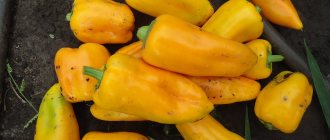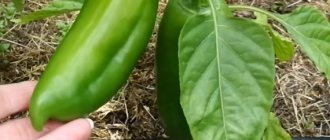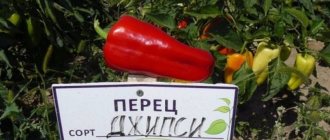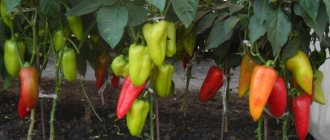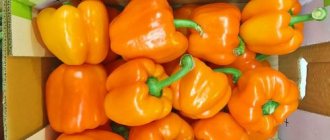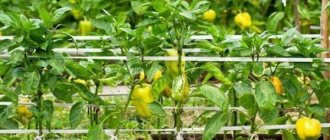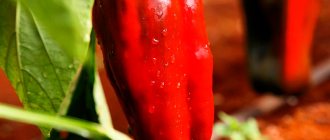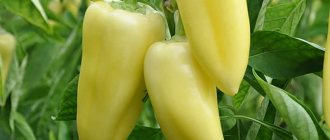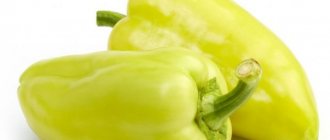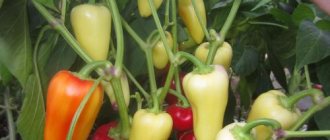Characteristics of pepper fruits Health
The fruits are medium-sized, cone-shaped, red in color at biological maturity, light green at technical ripeness. They set very well and ripen quickly.
- Wall thickness 3-4 mm.
- The average fruit weight is 40-50 grams.
- Productivity 4-5 kg per square meter.
Planting seeds for seedlings
Priming. For planting, use a ready-made substrate for peppers or a universal purpose one. But you can prepare the soil mixture yourself. To do this, you need to mix 2 parts peat + 1 part river sand + 2 parts humus. To get rid of pathogenic microflora, the soil is spilled with boiling water or a dark pink solution of potassium permanganate.
Seed preparation. For faster germination, pepper seeds are soaked in a nutrient solution of epin or another stimulant for one day. To do this, they are wrapped in cloth and placed in a solution. The next day, place the seeds on a saucer, cover with gauze folded in two layers and moisten well. After 2-3 days, the seeds should swell and germinate.
Landing. Make 1.5-2 cm depressions in the soil, lay out the seeds and sprinkle with the same soil. The crops are moistened with a spray bottle and covered with cellophane or glass. Open the plantings once a day to prevent mold from appearing on the soil. If the seeds are sown dry, the pepper can sprout in 2 to 4 weeks; if the seeds have already sprouted, the characteristic white loops will appear on the 5-6th day. The optimal indoor air temperature for germination is +25 degrees.
Taste qualities of pepper Health
The fruits have a sweet taste, both in biological and technical ripeness. The wall thickness is small, the skin is tender, and the flesh is juicy. Pepper is a universal purpose, perfect for fresh consumption, canning, freezing and drying. The peppers are small in size, there are a lot of peppers, they ripen very quickly.
Pepper Zdorovye is a time-tested variety; in 1986 it was officially registered and recommended for use in the northern regions.
Pepper Health can grow and produce fruit in low light and temperature conditions. This is one of the varieties from which you can get an early and good harvest even under unfavorable conditions.
- Sowing seedlings from late February to mid-March.
- Planting in a greenhouse in early to mid-May, when the threat of frost has passed
- Planting pattern 50 by 35 cm
- Harvest from late June to mid-September
Must be observed:
- Regular watering, the amount depends on weather conditions. The soil should not be too dry; most often, watering once a week is enough.
- weeding and loosening
- correct feeding: at the beginning of growth, for the development of the root system, phosphorus is needed, then, to gain green mass, nitrogen is needed before flowering, and during fruit set and ripening, potassium is needed.
Features of cultivation
Agricultural technology for peppers of the Zdorovye variety is relatively simple. Despite its early ripeness, like all varieties of pepper, it is grown through the seedling stage; seeds for greenhouse continuation are sown already in February. They can be sown in a small box, but they should be planted with 2-3 leaves in separate cups, or better yet, peat pots. By the time of transplantation into the greenhouse, the seedlings already have 10–12 leaves and the first flower clusters, sometimes the flowers even bloom already in the apartment.
As an ultra-early ripening variety, Zdorovye pepper has the right to bloom already in pots
By the time of transplantation, the soil in the greenhouse should warm up to at least 15 °C, the air - to at least 20 °C. This pepper is planted according to a pattern of 40 x 60 cm or a little less often, without deepening. The optimal temperature for growing is 22 to 28 °C, at night - not lower than 15 °C. It is necessary to ensure that it does not exceed 30 °C: in such conditions, fruits are not formed. Water and feed Zdorovye peppers in the same way as most similar varieties.
There is a recommendation about growing a bush with two stems. In reality, this pepper is removed from everything that has grown up to the first fork, and then the stems are simply tied up as needed. This pepper bears fruit for a long time, but the first wave, especially fruitful, passes by mid-summer. Everything that remains unharvested by the onset of autumn is harvested at any degree of ripeness.
Pros of the Health variety
- High fruit set even under unfavorable conditions
- Quite unpretentious: cold-resistant, withstands lack of lighting
- High vitamin content
- Disease resistance
- High taste qualities, including fruits at technical ripeness
- Versatility of use
- Possibility of early harvest
- Good for northern regions
- The variety is suitable for beginners
- The variety is suitable for beginners
- Can be grown on a windowsill
Seedling care
Watering. Pepper seedlings are watered with water at room temperature, mainly in the morning. It is not recommended to water the plants frequently, as this can lead to rotting of the roots. Water procedures are carried out as the top layer of soil dries.
Light. For good growth of pepper seedlings, the daylight hours should be at least 9-10 hours. On cloudy days, you can organize additional illumination with phytolamps.
Temperature conditions. To obtain healthy and strong seedlings during the day, the room temperature should be +23+25°C, at night from +16 to +18°C. If the room is cool around +12 degrees, then the plants will lag behind in growth and may die.
Picking. When two true leaves appear, the peppers are transplanted into larger containers. Do this carefully, without damaging the root system. The plants are buried no more than 0.5 cm. Another method of picking involves transplanting at the stage of two cotyledon leaves; such plants can be buried down to the leaves. At the same time, it is believed that peppers take root faster and begin to grow.
Cons of the Health variety
- small fruit size, thin walls
- need to tie up the plant
This is interesting:
- The best varieties of radishes The best varieties of radishes for open ground and greenhouses. Today I will tell you about five varieties...
- Growing greens: about varieties Today I will talk about delicious greens: different types of salads, mustard and even Chinese cabbage. Cabbage…
- What is the best way to exercise with or without a trainer? When we come to the gym, we wonder where to start and whether we need a trainer.…
Caring for peppers in a greenhouse
The temperature in the greenhouse for normal growth and development of plants should not exceed 28 °C and drop to 21 °C during the day and to 15 °C at night. It should be taken into account that at temperatures of +30 or more, pollen becomes sterile, which means that the formation of ovaries will be impossible. Water the peppers with warm water before 11 am. One adult plant requires 1.5-2 liters of water. The soil should not dry out, but the plantings should not be over-watered.
Feed peppers 1 or 2 times a month. It is important to use organic fertilizers with caution. Otherwise, you can end up with a “fat” bush without a harvest. Complex mineral fertilizer is used as fertilizing. The working solution is prepared according to the manufacturer's recommendations. Natural nutrition can be obtained by mulching plants with dry and fresh grass. Herbal infusion is completely harmless for feeding peppers.
It's very easy to prepare. Nettle, quinoa, sweet clover and other weeds are suitable for this. A large bunch of nettles is cut so that it fits in a 10-liter bucket and filled with water up to the lid. The fertilizer takes about 4-7 days to prepare; the contents of the container are stirred once a day. To feed peppers, use 1 liter of fertilizer per 10 liters of water. For one plant, 2 liters of diluted herbal infusion is enough.
Diseases
The “Health” pepper variety is resistant to blossom end rot, but there are other diseases that are best known in advance in order to prevent the disease or respond to the first signs in time.
- black leg (darkening of the root collar, wilting of plants) - loosening the soil, spraying with the “screen” preparation;
- late blight (hard black spots on fruits) - preparations “Barrier”, “Oxychom”.
- stolbur (yellowing, fruits of irregular shape) - removing diseased plants, loosening the soil, weeding;
- spotted wilt (starts from the top of the plant, the color of the leaves changes to a blue tint with a bronze tint) treatment of plants with foundationazole. When processing plants, treat the skin of your hands with a solution of potassium permanganate.
Agrotechnics of cultivation and care
Sweet peppers of this variety can be grown both in open ground and in a greenhouse. The yield in greenhouse conditions is higher than under film in open ground. Plants suffer less from cold and rain, but if frosts begin, even in a greenhouse, pepper will need additional protection.
You can plant cucumbers in the same bed with peppers, but tomatoes will be bad neighbors for them because they require different care conditions.
Peppers should be protected from drafts and planted in a place protected from cold winds. Peppers are demanding on soil fertility, so before planting they prepare the soil by adding humus, wood ash, urea, superphosphate and potassium sulfate in the fall. Manure cannot be applied; the bushes will grow a lot of foliage, but they will not be able to form fruits.
Seedlings are planted in a well-dug and fertilized bed. You can buy it on the market or grow it yourself from seeds at home.
The procedure for growing seedlings is as follows:
- Sowing is carried out at the end of February or the first half of March.
- Before planting seeds for seedlings, they are treated with a 1% solution of potassium permanganate for 20 minutes and then washed with clean water.
- Next, the seed material can be soaked in growth stimulants according to the instructions of the manufacturer of the selected product.
- Then place the seeds in a container with moistened soil at a distance of 2 cm from each other, and to a depth of 1 cm. The soil should be warm, 22–25 ° C.
- The container is covered with glass or film and placed in a warm place. After about a week, shoots appear at a temperature of +25 °C, the covering material is removed.
- Seedlings should grow in a well-lit place; they should not be overdried or overly flooded with water. By the time of planting in the ground (depending on weather conditions, this is approximately mid-May), the bushes should have about 8-12 leaves.
Beneficial properties of sweet pepper
The rich vitamin and mineral composition of the vegetable determines its benefits for the human body.
Find out the benefits and harms of green bell peppers.
It can have the following positive effects:
- strengthen the body's defenses to fight infections;
- stimulate the formation of gastric juice;
- increase appetite;
- improve peristalsis of the gastrointestinal tract;
- calm the nervous system;
- help reduce blood pressure;
- thin the blood;
- stimulate nail and hair growth;
- speed up metabolism;
- make blood vessels stronger;
- relieve insomnia;
- improve concentration.
Pepper is recommended to be used to prevent anemia, thrombosis, heart disease, stroke, osteoporosis, problems with the digestive tract, and cancer.
It is shown:
- for older people to strengthen memory;
- those who are engaged in mental work;
- patients with diabetes mellitus;
- smokers.
Benefits of black pepper for the human body: weight loss
It has long been noted that products containing piperine promote effective and rapid weight loss. Black pepper also contains this element, so this spice has the unique ability to burn fat even in the absence of sufficient physical activity.
To achieve your goal, the amount of pepper you eat per day should reach 2 grams. This amount of spice not only affects fat cells, destroying them, but also enhances intestinal motility (mild laxative effect). This also affects weight loss.
To enhance the effect, some advise drinking 1 glass of kefir with pepper (¼ teaspoon) and cinnamon (½ teaspoon) added to it. You should not often resort to this method of losing weight, because in addition to benefits, it can also bring negative consequences.
A mixture of black pepper and turmeric has long been on the list of golden recipes for people struggling with excess weight - the benefits of these two seasonings complement each other perfectly. The fact is that the substances of turmeric (in particular, curcumin) are removed from the body too quickly, sometimes without even having time to convey their valuable qualities. Pepper accelerates the absorption of beneficial elements, which means the maximum effect will be achieved.
